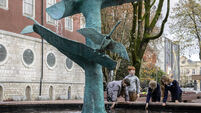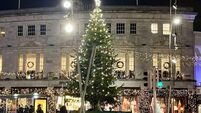Dr Catherine Conlon: Teens need a place to hang out in Cork city

The iconic, restored Counting House would be an ideal venue for teenage activities, says Dr Conlon
A restored landmark in Cork city is being considered as the site for a city library. Cork City Council is reportedly examining the feasibility of locating a new public library in the iconic Counting House on South Main Street, to replace the current one on Grand Parade.
I have a much better idea.
While the council is understood to be preparing a masterplan for the wider Grand Parade, where millions is being spent on public realm upgrades, why not use the Counting House to meet the needs of the thousands of teenagers and youth in the city?
The Counting House was restored in 2021 as office and cultural space, but the building has been vacant since. That same year, Taoiseach Micheál Martin announced a €400 million urban regeneration investment package in Cork. It is funding work in the docklands, including transport and mobility infrastructure, public realm schemes like the Marina Park, infrastructure to support thousands of new apartments, as well as the regeneration of the Grand Parade area including a revamp of Bishop Lucey Park.
What is missing in all of this is the specific needs of teenagers at a time when research identifies worrying trends in mental health of adolescents in Ireland.
Last September, researchers at RCSI University of Medicine and Health Sciences outlined how secondary-school aged adolescents in Ireland reported more mental health problems in 2021, including an increase in suicide attempts, compared to previous years.
More than a quarter of the adolescents described their mental health as ‘bad’ or ‘very bad,’ more than a third reported self-harming in their lifetime, and one in ten reported attempting suicide in their lifetime.
The study was carried out as part of the Planet Youth programme which will survey mental health and substance abuse problems in adolescents every two years. Yet when it comes to urban design and public realm infrastructure, the specific needs of teenagers and youth are inadequately addressed.
Teenagers, more than any other age groups, depend on public spaces. Evidence shows the vast majority (80%) prefer being outdoors than indoors, with almost 30% regularly using streets and parks for socialising.
In my neighbourhood, Beaumont Quarry is a haven for Cork’s urban wildlife but has also offered generations of teens a respite from adult supervision along with a sense of autonomy over their surroundings. A mountain of evidence demonstrates the need for teenagers to have independent space to build social networks, engage in recreational activities, and find a sense of belonging.
But the quarry, with its dangerous cliff edges and absence of lighting, is not ideal. Far more suitable are skate parks, basketball courts or informal settings within the urban space that facilitate socialisation.

There is evidence that facilities specifically designed for teenagers are used much more than similar spaces without this type of infrastructure - 73% of teens use these kind of spaces when they are available.
Even better is when young people’s voices are included in the process of ‘placemaking’. By being actively engaged in the creation of ‘youth spaces’, young people feel an investment in their community and develop a sense of ownership of their space.
While teenagers are among the most frequent users of public spaces, their needs are often overlooked in urban planning.
The much-lauded public realm space of the Marina Park has been built with the needs of small children and adults to the fore. There is an emphasis on quality with wonderful playgrounds being developed and benches and picnic tables for adults watching them. All along the marina are benches and seats for adults to chat and enjoy the open air and rest after their stroll along the promenade. The public spaces around Páirc Uí Chaoimh offer some amenities for skateboarding or playing ball, but otherwise the area is pretty devoid of spaces for teenagers to hang out.
Research across Europe highlights the importance of these spaces for teenagers’ social, physical, and emotional development.
The Factoria Joven, or ‘Youth Factory’, in Merida, Spain, provides a unique space for physical activity like skateboarding and rock climbing as well as indoor facilities for workshops and counselling.
Factoria is an example of a youth-specific space – a purpose-built facility more like a youth playground than anything else. Much of the space is built from recycled material. It has graffiti walls for urban art workshops, shelter from the rain as well as heat, skate ramps, bowls and rails, a rock climbing wall, a stage for performance, quality lighting, and facilities for tightrope walking.
The facility also caters for group counselling sessions as well as music and dance workshops. The emphasis is on informal activities and the ability to take risks in constructive ways while the indoor facilities provide a point of contact for local community workers to offer a range of supports.
Here, teens can be supported to use the space for recreation but also the opportunity to express themselves throughout street art – once considered a form of vandalism but now recognised as a powerful tool to showcase teenage creativity in a way that enriches the urban aesthetic.
There is mounting evidence of the benefits of legal graffiti walls or areas designed for youth performance, like stages for music and dance used and valued by teenagers. Fashion can also play a key role where teenagers use these spaces to display their latest trends, hairstyles and accessories as they express their individuality in their own space.
The Re-Gen network of cities across Europe has taken on the challenge of testing how sports and recreational facilities can rejuvenate public spaces and empower adolescents.
Whether it’s a skateboarder upgrading his skills or a group of friends shooting hoops or playing ping pong, these spaces are designed to invite participation and foster community.
Daugavpils in Latvia focused on physical events to activate public spaces with festivals combining streets sports and cultural activities in neglected neighbourhoods. Events like the Youth Summer Festival foster social interaction and encourage young people to engage with their urban environment.
Similar co-design processes in the San Siro district in Milan empowered teenagers to plan community events that combined sports, music and culture, highlighting how giving young people a voice could lead to the development of spaces that resonate deeply with them.
When young people are given the opportunity to shape their environments, they tend to move beyond being passive users (and vandals) to becoming active stakeholders. This fosters a deep sense of ownership and pride, ensuring the spaces reflect their vision and aspirations and identity.
Isn’t it time we included the vision of teenagers and young adults in Cork in the urban regeneration of the city? What better way to use the Counting House than to foster the needs of the city’s youth?
Isn’t it time we adults dropped the idea that young people are ‘at risk’ or ‘troublesome’, and began to see them as a vital and valuable part of the city’s future?







 App?
App?







